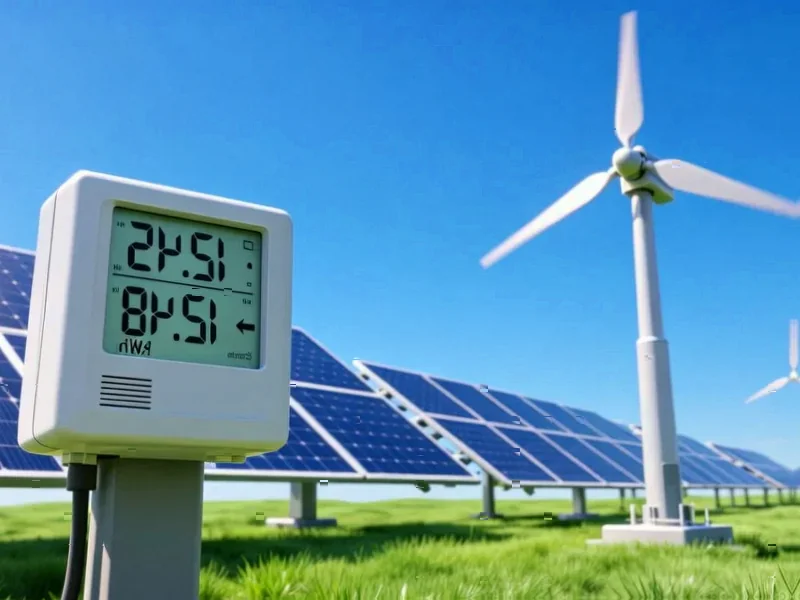According to SciTechDaily, researchers at Nanjing University of Aeronautics and Astronautics have developed a floating droplet electricity generator that uses natural water as both structural support and conductive electrode. The new design reduces material weight by approximately 80% and cuts costs by roughly 50% compared to traditional droplet generators while maintaining similar electrical output of around 250 volts per droplet. The team demonstrated a 0.3-square-meter integrated device that could power 50 LEDs simultaneously and charge capacitors within minutes, with their findings published in National Science Review on August 4, 2025. The floating generator maintained performance across varying temperatures, salt concentrations, and even exposure to outdoor lake water with biofouling, representing a significant advancement toward practical hydrovoltaic applications. This breakthrough suggests we may be approaching a new era of water-integrated renewable energy.
The Engineering Innovation Behind Water as Electrode
What makes this research particularly compelling is how it fundamentally rethinks the relationship between energy harvesting devices and their environment. Traditional approaches treat water as something to be managed or contained, whereas this design embraces water’s natural properties as functional advantages. Water’s incompressibility provides mechanical stability, its surface tension enables controlled droplet spreading, and its ionic content serves as a natural charge carrier. This represents a shift from what I’d call “imposed engineering” – where we force materials to behave how we want – toward “adaptive engineering” that works with natural phenomena. The drainage hole design that exploits surface tension to prevent water accumulation is particularly clever, addressing a fundamental challenge that has plagued many previous water-based energy systems.
The Reality Check: Scaling From Lab to Lake
While the laboratory results are impressive, the path to practical deployment faces several significant hurdles that the research paper acknowledges but may underestimate. Real-world rainfall varies dramatically in droplet size, velocity, and frequency – factors that laboratory conditions can’t fully replicate. A 0.3-square-meter prototype is indeed larger than previous attempts, but scaling to the square meters or even acres needed for meaningful power generation introduces entirely new engineering challenges. Maintaining dielectric film integrity across large areas in dynamic aquatic environments with waves, debris, and biological growth represents a substantial materials science problem. The researchers mention biofouling resistance, but anyone familiar with marine technology knows that long-term biological accumulation can defeat even the most sophisticated anti-fouling strategies.
Where This Technology Actually Makes Sense
The most immediate applications likely lie in specialized environmental monitoring rather than grid-scale power generation. The ability to power 50 LEDs or charge capacitors for small sensors suggests this technology could be ideal for distributed environmental monitoring networks where replacing batteries is impractical. Think of water quality sensors in remote lakes, salinity monitors in coastal areas, or pollution detection systems where occasional rainfall could provide maintenance-free operation. These applications leverage the technology’s strengths while avoiding its limitations in power density. The concept of “land-free” energy harvesting is particularly valuable in ecologically sensitive areas where traditional infrastructure would be disruptive. As the researchers note in their publication, this could complement existing renewable technologies rather than replace them.
The Cost Equation and Manufacturing Challenges
The claimed 50% cost reduction sounds impressive, but the economic viability depends heavily on manufacturing scalability and durability. While reducing material weight by 80% certainly lowers raw material costs, the manufacturing processes for large, durable dielectric films that can withstand years of environmental exposure may introduce new cost challenges. The true test will come when researchers attempt to manufacture these systems at scale while maintaining performance and longevity. Previous hydrovoltaic technologies have often stumbled at this stage, where laboratory efficiency fails to translate to cost-effective mass production. The integration with Google’s research platforms as indicated in their profile suggests the team understands the importance of scalable data management, but manufacturing scalability remains a separate challenge.
A Promising Step Toward Nature-Integrated Energy
This research represents more than just another energy harvesting device – it points toward a broader philosophy of “nature-integrated design” that could influence multiple fields. By using abundant natural materials as functional components rather than fighting against them, this approach could lead to more sustainable and resilient technologies. The demonstration that water can effectively replace both structural components and electrodes suggests we may be underestimating nature’s engineering capabilities. While practical deployment challenges remain, the fundamental insight – that we can design systems that work with natural processes rather than against them – could have implications far beyond rain power generation. This research deserves attention not just for what it accomplishes technically, but for the design philosophy it represents.




